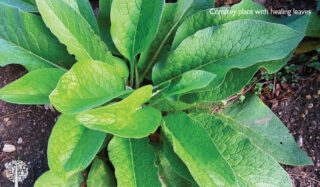With a strong focus on health over the past few years, many people are looking for ways to be more self-reliant. Many have struggled to access health services in a timely fashion. So, it’s not surprising there is a resurgence of interest in using plants for medicinal purposes. Creating a themed Pharmacy Garden is one way to be more self-sufficient in treating everyday ailments.
For example, pain and healing from cuts, stings, and bruises can be managed by growing and using the right plants. The other day, an angry hornet stung me on the face and arm while watering the garden. The swelling and pain were immediate. I returned to the house and cut an aloe vera leaf from the mother plant. I applied the cooling, soothing gel inside the leaf to the swollen stings and dabbed some plantain salve on the area. The pain diminished within minutes, and the healing began. No need for pain medication, a first aid kit, or a trip to the chemist or doctor! My garden is a ‘medicine cabinet’ waiting to be used when needed. It’s incredibly empowering to know which plants to use and when.
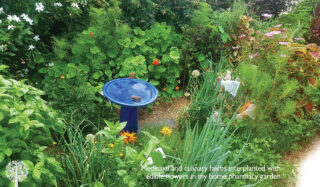
So, how do you create a medicinal garden?
Step 1: List the most common ailments in your household. If you have children or are out in the garden frequently, stings, bites, sunburn, scratches, wounds and bruises are likely! If you suffer from regular headaches, stress or anxiety, insomnia, sore throats, coughs, and colds, there are plants you can grow and use to relieve many symptoms and jumpstart healing. A list will help you focus on choosing plants that best meet your unique needs. Most medicinal herb books are an excellent place to start.
Step 2: Match the ailments on your list to plants useful for prevention, treatment or healing. Many herbs and food plants perform double duty with culinary and medicinal uses. You can benefit your health from the nutrients they contain and use many for their therapeutic effects for specific conditions. Look for plants that perform multiple roles and are suited to your climate; this allows you to grow fewer plants of higher value.
Step 3: Start with the most common, easy-to-grow plants that will give you confidence in using them for healing. Learn how to make herbal teas, salves and poultices. These are some of the easiest ways to use plant material without much time, money or effort. We generally want a quick solution when we feel sick or have a minor ailment. However, not all plants give up their healing benefits in the same way. We can eat some herbs, but others are best made into herbal tea or pulverized and applied to the skin as a poultice. Some plants perform best when added to other ingredients to make a salve, oil or tincture.
You can either grow medicinal plants in containers or set aside an area of your garden specifically for this purpose. Start small and add more plants as you need. I have a home pharmacy garden close to the kitchen, so I can dash out and pick fresh ingredients for meals and herb teas or other remedies. I interplant them with edible flowers like calendula, dianthus and violets. Aim to group plants according to their sun and water needs.
6 Best Medicinal Plants And Their Benefits
Sage, rosemary, and thyme are perennial herbs well-known for their flavor and hardy nature, even in the harshest conditions. This trio of herbs are a great starting point for a mini medicinal garden that can be expanded plant by plant. I highly recommend three others in a basic pharmacy garden: aloe vera, nasturtiums, and comfrey. Their properties cover a wide range of uses for common ailments.
1. Sage (Salvia officinalis). A perennial clumping herb that does best in full sun. It prefers well-drained soil with low to moderate water needs. Make sage tea with fresh or dried leaves by steeping for 3-5 minutes in boiling water. This remedy is widely used as a tea or mouthwash for sore throats, laryngitis, indigestion, depression, anxiety, and grief. The leaves contain antibacterial properties and can be smeared over wounds after cooking them in vinegar.
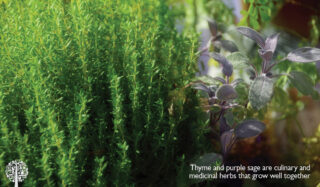
2. Rosemary (Rosmarinus officinalis). A perennial clumping and bushy herb that thrives in full sun, well-drained soil and minimal water. It is the ‘herb of remembrance’ for aiding memory and mental clarity. Rubbing and crushing the leaves releases essential oil compounds. Inhaling this aroma has an almost immediate effect on stimulating the brain and improving concentration. The leaves can also be rubbed over the temples to relieve a headache. The essential oils in the leaves and flowers have antiseptic, anti-fungal, anti-inflammatory, and antibacterial properties. In addition, regularly eating rosemary provides a rich source of phytonutrients that can help build the immune system.
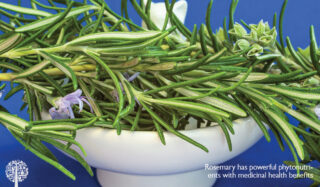
3. Thyme (Thymus species). This perennial low-growing and spreading herb prefers full sun to partial shade in well-drained soil with low to moderate water needs. It partners well with rosemary and sage in a garden as they all share the same requirements. Thyme contains antiseptic, antimicrobial, anesthetic, and antibacterial compounds that help keep infections at bay and are beneficial for healing. Combine the three herbs in tea!
Add fresh or dried leaves to boiling water to make thyme tea. The essential oil in the leaves contains thymol, a pain-relieving compound helpful as a simple remedy for many common ailments. Hot thyme tea may be sipped to ease a sore throat or poured into a bowl and inhaled to relieve a blocked nose, cough or cold. The warm tea can be used as a throat or mouthwash gargle for inflamed gums and laryngitis (combined with sage) and to destroy germs. Cooled thyme tea may be applied topically to the skin to alleviate and soothe rashes and sores.
4. Aloe vera (Aloe barbadensis). Often referred to as the Medicinal Plant or Living First Aid Plant, it lives up to its name! Aloe vera is a perennial drought-hardy succulent that thrives in full sun or a well-lit bathroom where it will be used regularly. It has to be one of the planet’s lowest maintenance, highest value medicinal plants. Aloe vera has anti-aging, moisturizing, healing, and soothing properties, making it an incredibly useful healer for all skin complaints. The gel inside the leaves is used to heal burns, as a daily moisturizer or aftershave balm, and to heal cuts, bites, stings, blisters, infections, sunburn, and many other ailments. We have many plants that we use daily. Aloe vera has anti-inflammatory, antiseptic, and antimicrobial properties, making it a ‘go-to’ remedy quickly absorbed into the skin.
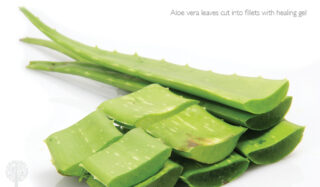
5. Nasturtium (Tropaeolum majus). This attractive annual herb flowers abundantly in full sun and grows more leaves in the shade. It’s tolerant of many soils and has moderate water needs. All plant parts are edible – flowers, leaves, buds, and seeds. Research studies(1, 2) show the leaves have antimicrobial, antibiotic, and general tonic properties. Tromalyt is the fast-acting antibiotic compound present in nasturtiums. One of the key reasons to have this natural remedy on hand is that nasturtiums don’t negatively impact the gut microbiome as pharmaceutical antibiotics do.
Nasturtiums also have anti-fungal and antiseptic properties. Whenever I feel a cold or flu coming on, I eat three leaves or seeds several times during the day. They are rich in Vitamin C and consistently ward off illness.
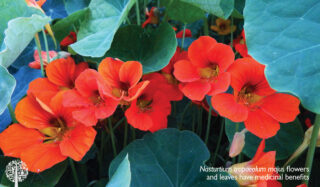
6. Comfrey (Symphytum officinale). Also known as Knitbone and All Heal. This clumping perennial and flowering herb tolerates full sun to partial shade and has moderate water needs. When I was a young girl, I spent a lot of time playing outdoors and falling out of trees, ending up with regular bruises (internal bleeding). So my mum grew comfrey and applied a fresh leaf poultice (a paste from the crushed leaves spread over a warm, moist cloth). This helped relieve inflammation, draw out bruising, reduce swelling, and encourage faster healing. Over the years, I’ve used it to help heal sprains, bruising, broken bones and joint injuries. Of course, it has many other uses, but these alone earn it a place in a pharmacy garden.
General Precautions
Paracelsus wisely said, “All things are poison, and nothing is without poison. The dosage makes it either a poison or a remedy.” Consult your healthcare provider to determine if any medications you are taking could interact with the herbs you intend to use and research their contraindications.
Following these simple steps, you can grow a healing home pharmacy garden supporting your health and well-being for many years.
References:
(1) ‘Antimicrobial and anti-inflammatory activities of the volatile oil compounds from Tropaeolum majus L. (Nasturtium)’, African Journal of Biotechnology Vol. 10(31), pp. 5900-5909, 29 June, 2011
(2) ‘Traditional uses, botany, phytochemistry, pharmacology, separation and analysis technologies of Euonymus alatus (Thunb.) Siebold: A comprehensive review.’ J Ethnopharmacol. Fan L, Zhang C, Ai L, Wang L, Li L, Fan W, Li R, He L, Wu C, Huang Y. 15 Sep 2020; 259:112942.
